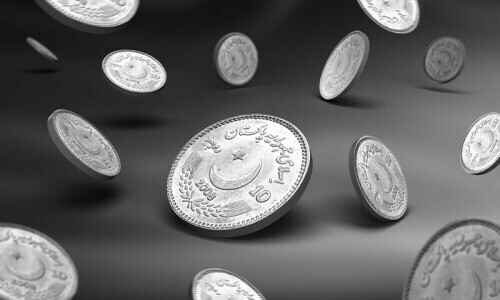ISLAMABAD: To boost economic growth to 3.6% from 2.38pc in the previous fiscal year, the Annual Plan Coordination Committee (APCC) approved a National Development Plan (NAP) worth over Rs3 trillion for 2024–25 on Friday. Included in this plan is the federal Public Sector Development Programme (PSDP), which is worth Rs1.221 trillion.
The PSDP of Rs1.221 trillion is about thirty percent more than the Rs950 billion allotment for the current year, which has since been reduced to Rs717 billion due to financial difficulties. The power providers would also be investing an additional Rs185 billion outside of the PSDP, bringing the total amount spent for federal development to Rs1.406 trillion.
When considering the total revenue proceeds of the two provinces, the Rs2.869tr NAP, excluding the Power Division, also featured an opulent Rs763bn for Sindh and a modest Rs700bn for Punjab.
While the ADP of Balochistan was not mentioned by the APCC, which is led by Deputy Chairman Jehanzeb Khan of the Planning Commission, Khyber Pakhtunkhwa had proposed a separate ADP worth Rs627 billion. Thus, it is anticipated that the entire amount spent on national development exceeds Rs3.5 trillion.
The federal government has drastically curtailed its social sector responsibilities by cutting its budget for FY24 to Rs83 billion, down 59 percent from Rs203 billion. This is a significant shift from current policy.
Similarly, the central government has maintained the current year’s funds for development in Gilgit-Baltistan, tribal merged districts, and Azad Kashmir. Rather, it has led to a 60 percent rise in federal investments in infrastructure (Rs877 billion) and a 148 percent increase in Science & Technology (Rs104 billion) over the current year.
The energy sector would receive the greatest allocation from the government PSDP next year, at Rs378 billion, which is 212 percent more than the Rs121 billion first allotment from this year. Similarly, the water sector has been allotted Rs284 billion, a 92 percent increase over the Rs148 billion from this year.
However, the transportation and communication industry is expected to earn only Rs173 billion next year, a 29 percent decrease from Rs245 billion this year.
The social sector would be the biggest loser as the center distributes responsibility for health and education to the provinces, resulting in a 59 percent reduction in financing overall to Rs83 billion.
As a result, funding for the health sector has been cut by 35% to Rs17 billion, and spending on education—including higher education—has been cut by nearly 62% to Rs32 billion from Rs83 billion in the current fiscal year.
Positively, instead of spending Rs61 billion this year, allotment for the so-called Sustainable Development Goals (SDG), which have been abused for political schemes, has been fully eliminated for the following year. The amount allotted to governance has grown by 38% to Rs29 billion. In comparison to current year, the agriculture sector would receive Rs. 14 billion next year.
The growth target for 2019 has been set at 3.6 percent, with growth in services accounting for 4.1 percent, 4.4 percent in the industrial sector, and 2 percent in agriculture. The planning commission stated that the growth prospects are contingent upon several factors, including “political stability, exchange rate stability on the back of improvement in external account and external inflows, macroeconomic stabilization under IMF’s program and expected fall in global oil and commodity prices.”
The agriculture sector’s projected 2 percent increase for the upcoming year indicates a significant slowdown in the growth rate. Due to the severity of the dry weather spell and insufficient water availability from lower-than-normal rainfall, particularly in the case of Kharif crops, the output of major crops is predicted to decline by 4.5 percent. It is anticipated that the livestock and other agriculture subsectors will rise at 3.8 and 4.3 percent, respectively.
On the strength of anticipated LSM growth of 3.5 percent, the industrial sector is anticipated to rebound in 2023–2024 with planned growth of 4.4 percent. Improved input and energy supplies as a result of the predicted drop in global oil and commodity prices, additional relaxation of import restrictions, increased public sector spending, exchange rate stability, and a drop in interest rates are all projected to support this.
These factors would likely result in lower pricing for building materials, which will help the construction sector meet its growth objective of 5.5 percent in 2024–2025.
The forecast growth rate for the services sector is 4.1 percent. The intended development in the services sector will be complemented by the anticipated 3.1 percent growth in the sectors that produce commodities. Increased economic activity in the manufacturing and wholesale sectors of the economy will lead to improved growth in the transportation, storage, wholesale and retail trade, communications, etc.
Because to anticipated economic turnout, a stronger business environment, and political stability, the total investment-to-GDP ratio is predicted to increase from 13.1 percent in 2023–2024 to 14.2 percent in 2024–2025.
Fixed investment is expected to grow by 27.6pc on a nominal basis, whereas as a percentage of GDP, it is expected to increase from 11.4pc in 2023-24 to 12.5pc in 2024-25. National savings are targeted at 13.3pc of GDP for 2024-25, up from 13pc this year.
The government expects the fiscal deficit to narrow due to fiscal consolidation measures, with a focus on enhancing tax revenue and curtailing non-development expenditures, including subsidies.
Monetary policy will be aligned with the objectives of inflationary expectations and growth revival. With falling global inflation, domestic average inflation is expected to moderate to 12pc next year.
According to the Planning Commission, additional relaxation of import restrictions is anticipated in 2024–2025 in order to meet growth targets, particularly the resurgence of the industrial sector, and a widerning of the current account deficit.
The exchange rate and foreign exchange reserves will be under pressure from the external debt repayment schedule. Positive prospects for exports, foreign inflows, and remittances will lessen these pressures, nevertheless.








